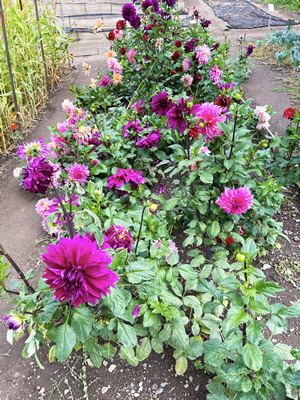Dahlia Dividing Observations In 2021, we established an experimental 10-Bed Unit (10BU) at TJC complementing the ongoing research on this topic at VGFP and other 10-BU locations globally. The diet design for this experimental bed included dahlias as a versatile carbon/calorie/income crop. You can find a good intro to edible dahlias here.
Once you take the tubers out of the ground you then can decide whether you want to divide them or not. If you decide to leave them undivided, then you will likely have strong healthy plants with even larger tuber balls next year. However, if you do decide to divide the tubers, you can multiply the amount of plants you have, and harvest some tubers for eating; but you do run the risk of butchering all your tubers. The dividing process is very delicate and complex so it is important to have good tools and be vigilant in your method. Dahlia roots consist of the main body of the tuber, then often have a very skinny neck, and then connect to the main stem. Where the neck connects to the main stem there is a little eye that looks similar to a potato eye. In order for each tuber to grow a new plant, it must have all its parts intact: the main body, the neck, and the eye. It is easiest spot the eye if you divide the tubers the same day they are dug from the ground. The longer the tubers are out of the ground the harder it becomes to spot the eyes. NOT ALL TUBERS YOU DIVIDE WILL END UP HAVING EYES. It is totally natural that some dahlia tubers will break off at the neck or not have an eye. Only about 50% of your tuber will produce viable plants in the spring. Whatever breaks or you don’t need, you can set aside to eat. You could also choose to wait until the spring to divide the tubers once they have already sprouted, but this method also comes with its benefits and challenges. It will likely be easier to see the tuber eyes once they have sprouted, however, it may be more challenging to actually split the tubers. By waiting to split the tubers I suspect you will also get fewer splits and could alter the amount you harvest for food. Steps to divide Tubers If you are planing to dig up dahlia tubers do it on the week of the first frost. Make sure your Dahlias are labeled before they stop producing flowers.
♥ top | Newsletter Home |Table of Contents| Archive
|


 Yesterday in the garden I mostly divided Dahlia tubers. They are such incredible and beautiful plants and the dividing process is so particular that it brought me some sense of anxiety to just start hacking them up. Each year when you plant a dahlia tuber it will multiply, producing a ball of many often interwoven tubers. In some locations where it only lightly freezes, dahlias can be left in the ground over winter. However in places that experience a hard freeze it is best to take the tubers out of the ground.
Yesterday in the garden I mostly divided Dahlia tubers. They are such incredible and beautiful plants and the dividing process is so particular that it brought me some sense of anxiety to just start hacking them up. Each year when you plant a dahlia tuber it will multiply, producing a ball of many often interwoven tubers. In some locations where it only lightly freezes, dahlias can be left in the ground over winter. However in places that experience a hard freeze it is best to take the tubers out of the ground.